Scarcity of resources is one of the more basic concepts of economics. Scarcity necessitates trade-offs, and trade-offs result in an opportunity cost. While the cost of a good or service often is thought of in monetary terms, the opportunity cost of a decision is based on what must be given up (the next best alternative) as a result of the decision. Any decision that involves a choice between two or more options has an opportunity cost.
Opportunity cost contrasts to accounting cost in that accounting costs do not consider forgone opportunities. Consider the case of an MBA student who pays $30,000 per year in tuition and fees at a private university. For a two-year MBA program, the cost of tuition and fees would be $60,000. This is the monetary cost of the education. However, when making the decision to go back to school, one should consider the opportunity cost, which includes the income that the student would have earned if the alternative decision of remaining in his or her job had been made. If the student had been earning $50,000 per year and was expecting a 10% salary increase in one year, $105,000 in salary would be foregone as a result of the decision to return to school. Adding this amount to the educational expenses results in a cost of $165,000 for the degree.
 Opportunity cost is useful when evaluating the cost and benefit of choices. It often is expressed in non-monetary terms. For example, if one has time for only one elective course, taking a course in microeconomics might have the opportunity cost of a course in management. By expressing the cost of one option in terms of the foregone benefits of another, the marginal costs and marginal benefits of the options can be compared.
Opportunity cost is useful when evaluating the cost and benefit of choices. It often is expressed in non-monetary terms. For example, if one has time for only one elective course, taking a course in microeconomics might have the opportunity cost of a course in management. By expressing the cost of one option in terms of the foregone benefits of another, the marginal costs and marginal benefits of the options can be compared.As another example, if a shipwrecked sailor on a desert island is capable of catching 10 fish or harvesting 5 coconuts in one day, then the opportunity cost of producing one coconut is two fish (10 fish / 5 coconuts). Note that this simple example assumes that the production possibility frontier between fish and coconuts is linear.
Relative Price
Opportunity cost is expressed in relative price, that is, the price of one choice relative to the price of another.
For example, if milk costs $4 per gallon and bread costs $2 per loaf, then the relative price of milk is 2 loaves of bread. If a consumer goes to the grocery store with only $4 and buys a gallon of milk with it, then one can say that the opportunity cost of that gallon of milk was 2 loaves of bread (assuming that bread was the next best alternative).
In many cases, the relative price provides better insight into the real cost of a good than does the monetary price.
Applications of Opportunity Cost
The concept of opportunity cost has a wide range of applications including:
* Consumer choice
* Production possibilities
* Cost of capital
* Time management
* Career choice
* Analysis of comparative advantage
Source: www.netmba.com
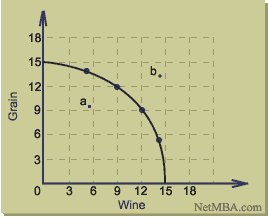 The PPF shows all efficient combinations of output for this island economy when the factors of production are used to their full potential. The economy could choose to operate at less than capacity somewhere inside the curve, for example at point a, but such a combination of goods would be less than what the economy is capable of producing. A combination outside the curve such as point b is not possible since the output level would exceed the capacity of the economy.
The PPF shows all efficient combinations of output for this island economy when the factors of production are used to their full potential. The economy could choose to operate at less than capacity somewhere inside the curve, for example at point a, but such a combination of goods would be less than what the economy is capable of producing. A combination outside the curve such as point b is not possible since the output level would exceed the capacity of the economy. 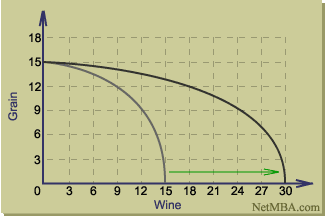 In the above diagram, the new technique results in wine production that is double its previous level for any level of grain production.
In the above diagram, the new technique results in wine production that is double its previous level for any level of grain production. 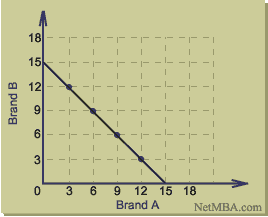 Note that to increase production of Brand A from 0 to 3000 bottles, the production of Brand B must be decreased by 3000 bottles. This opportunity cost remains the same even at the other extreme, where increasing the production of Brand A from 12,000 to 15,000 bottles still requires that of Brand B to be decreased by 3000 bottles. Because the two products are almost identical in this case and can be produced equally efficiently using the same resources, the opportunity cost of producing one over the other remains constant between the two extremes of production possibilities.
Note that to increase production of Brand A from 0 to 3000 bottles, the production of Brand B must be decreased by 3000 bottles. This opportunity cost remains the same even at the other extreme, where increasing the production of Brand A from 12,000 to 15,000 bottles still requires that of Brand B to be decreased by 3000 bottles. Because the two products are almost identical in this case and can be produced equally efficiently using the same resources, the opportunity cost of producing one over the other remains constant between the two extremes of production possibilities.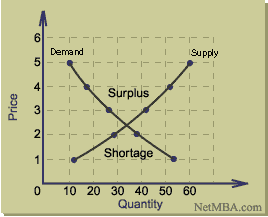 On this graph, there is only one price level at which quantity demanded is in balance with the quantity supplied, and that price is the point at which the supply and demand curves cross.
On this graph, there is only one price level at which quantity demanded is in balance with the quantity supplied, and that price is the point at which the supply and demand curves cross.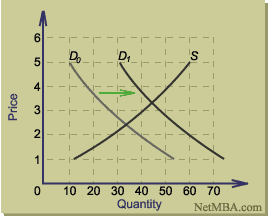 In this example, the positive shift in demand results in a new supply-demand equilibrium point that in higher in both quantity and price. For each possible shift in the supply or demand curve, a similar graph can be constructed showing the effect on equilibrium price and quantity. The following table summarizes the results that would occur from shifts in supply, demand, and combinations of the two.
In this example, the positive shift in demand results in a new supply-demand equilibrium point that in higher in both quantity and price. For each possible shift in the supply or demand curve, a similar graph can be constructed showing the effect on equilibrium price and quantity. The following table summarizes the results that would occur from shifts in supply, demand, and combinations of the two.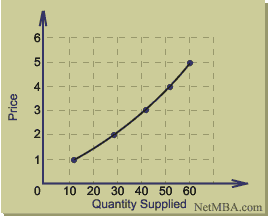 As with the demand curve, the convention of the supply curve is to display quantity supplied on the x-axis as the independent variable and price on the y-axis as the dependent variable.
As with the demand curve, the convention of the supply curve is to display quantity supplied on the x-axis as the independent variable and price on the y-axis as the dependent variable.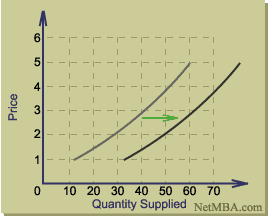 There are several factors that may cause a shift in a good's supply curve. Some supply-shifting factors include:
There are several factors that may cause a shift in a good's supply curve. Some supply-shifting factors include: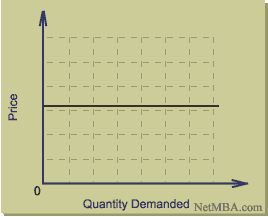
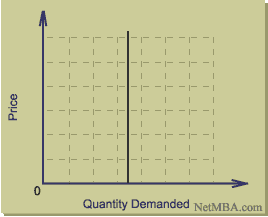
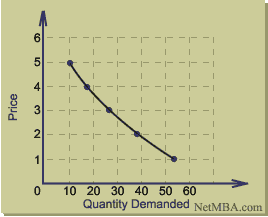 By convention, the demand curve displays quantity demanded as the independent variable (the x axis) and price as the dependent variable (the y axis).
By convention, the demand curve displays quantity demanded as the independent variable (the x axis) and price as the dependent variable (the y axis).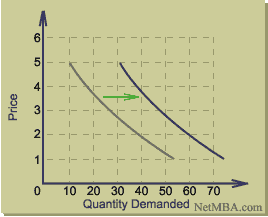 A number of factors may influence the demand for a product, and changes in one or more of those factors may cause a shift in the demand curve. Some of these demand-shifting factors are:
A number of factors may influence the demand for a product, and changes in one or more of those factors may cause a shift in the demand curve. Some of these demand-shifting factors are:
